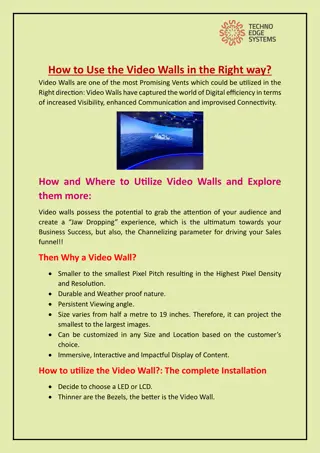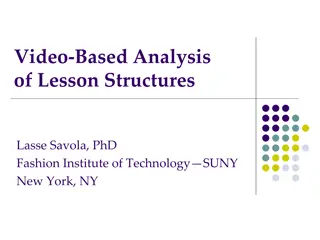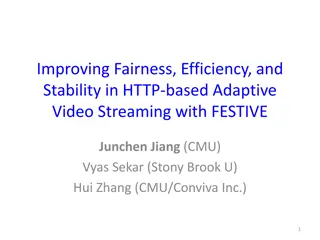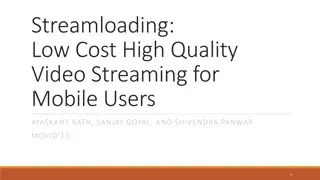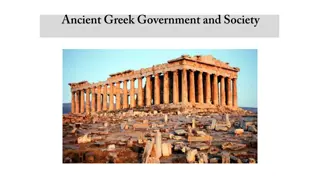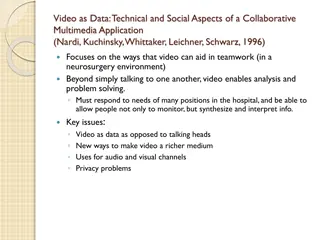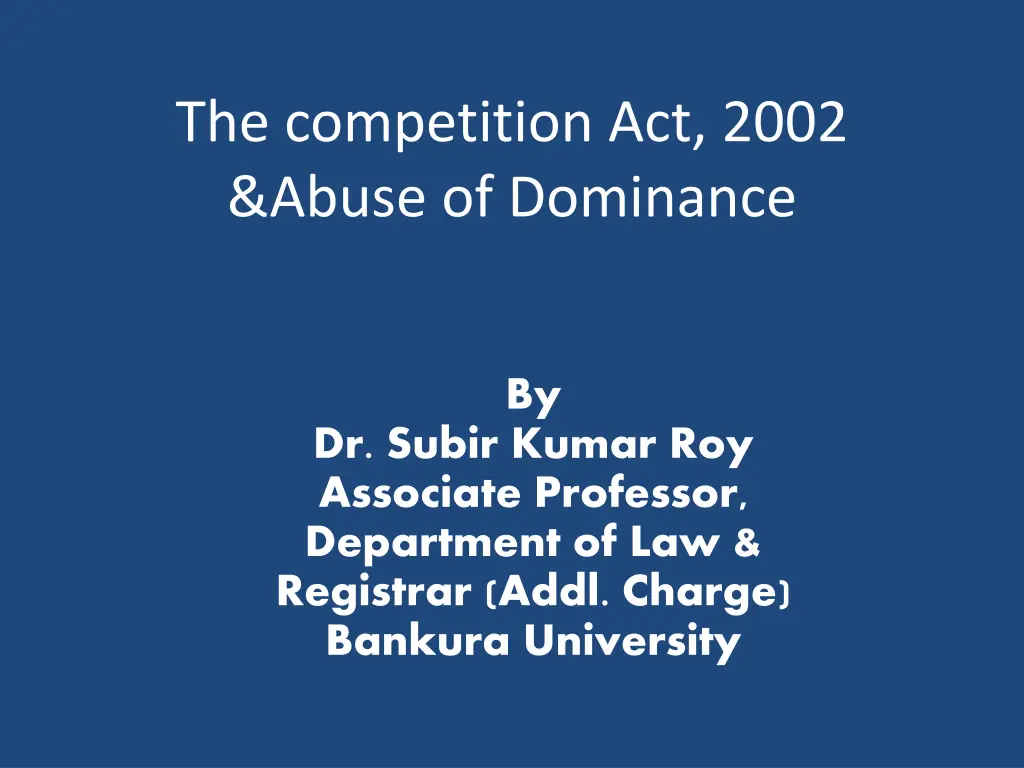
Abuse of Dominance in Competition Act 2002
Explore the provisions of the Competition Act 2002 regarding abuse of dominance, marking a departure from the earlier anti-monopoly law. Learn about the three-step process for establishing abuse of dominance and the relevant product market. Discover how Sec.4 prohibits various practices that can adversely affect competition and consumers.
Uploaded on | 1 Views
Download Presentation

Please find below an Image/Link to download the presentation.
The content on the website is provided AS IS for your information and personal use only. It may not be sold, licensed, or shared on other websites without obtaining consent from the author. If you encounter any issues during the download, it is possible that the publisher has removed the file from their server.
You are allowed to download the files provided on this website for personal or commercial use, subject to the condition that they are used lawfully. All files are the property of their respective owners.
The content on the website is provided AS IS for your information and personal use only. It may not be sold, licensed, or shared on other websites without obtaining consent from the author.
E N D
Presentation Transcript
The competition Act, 2002 &Abuse of Dominance By Dr. Subir Kumar Roy Associate Professor, Department of Law & Registrar (Addl. Charge) Bankura University
This provision marks a departure from the erstwhile anti-monopoly law, the Monopolies and Restrictive Trade Practices (MRTP) Act, 1969, which presumed 'big' to be 'bad'. In contrast, the Act only prohibits abuse of dominance and not dominance per se. Abuse of dominance Sec.4 of the Competition Act, 2002 "Dominant Position has been appropriately defined in the Act in terms of the position of strength, enjoyed by an enterprise, in the relevant market, in India, which enables it to (i) operate independently of competitive forces prevailing in the relevant market; or (ii) affect its competitors or consumers or the relevant market, in its favour
section 4 of the Act provides for a three-step process for establishing an abuse of dominance:" determination of the relevant market; establishing dominance in the relevant market; and establishing abuse of such dominance by an enterprise.
Relevant Product Market The 'relevant geographic market' is defined as a market comprising the area in which the conditions of competition for supply of goods or provision of services or demand of goods or services are distinctly homogenous and can be distinguished from the conditions prevailing in the neighbouring areas. services, their prices and intended use. market comprising all those products or services which are regarded as interchangeable or substitutable by the consumer, by reason of characteristics of the products or
Sec.4 prohibits the abuse of dominant position which is expressly mentioned in Sec.4(1) As per Sec.4(2) Abuse of dominance having an appreciable adverse effect on competition occurs if an enterprise, (a) directly or indirectly, imposes unfair or discriminatory- condition in purchase or sale of goods or service; or price in purchase or sale (including predatory price) of goods or service or (b) limits or restricts- a. production of goods or provision of services or market or b. technical or scientific development relating to goods or services and thereby vitiates the interest of the of consumers; or (c) indulges in practice or practices resulting in denial of market access; or (d) makes conclusion of contracts subject to acceptance by other parties of supplementary obligations which, by their nature or according to commercial usage, have no connection with the subject of such contracts; or (e) Uses its dominant position in one relevant market to enter into, or protect, other relevant market.
As per Sec. 18 of the Competition Act, 2002 empowers the Competition Commission of India to eliminate the practices having the adverse impact of competition and to promote the culture of competitive environment in market, to protect the interest of the consumers and to ensure the entry of all types of market players in the market mechanism so that they may carry their trade, business etc. without any hindrance or impediments. Sec. 19 along with Sec.18 e enable the CCI to keep vigil on the market system and monitor the market mechanism so that no one can do anything adverse or hostile to the competition in market. By virtue of Sec. 19 The commission may enquire into the alleged contravention of anti-competitive agreement and abuse of dominant position. As per Sec.19(4) CCI consider the following factors in order to determine whether any avocation(s) abuse the dominant position or not: P.T.O.
i. market share of the enterprise; ii. size and resources of the enterprise; iii. size and importance of the competitors; iv. economic power of the enterprise including commercial advantages over competitors; v. vertical integration of the enterprise, or sale or service network of such enterprise; vi. dependence of consumers on the enterprise; vii. monopoly or dominant position whether acquired as a result of any statute or by virtue of being a Government company or a public sector undertaking or otherwise; P.T.O.
viii. entry barriers including barriers such as regulatory barriers, financial risk, high capital cost of entry, marketing entry barriers, technical entry barriers, economies of scale, high cost of substitutable goods or service for consumers; ix. countervailing buying power; x. market structure and size of market; xi. social obligations and social costs; xii. relative advantage, by way of the contribution to the economic development, by the enterprise enjoying a dominant position having or likely to have an appreciable adverse effect on competition; xiii. any other factor which the Commission may consider relevant for the inquiry.


